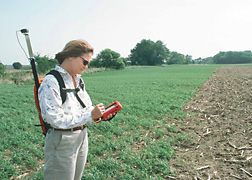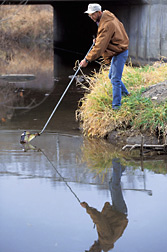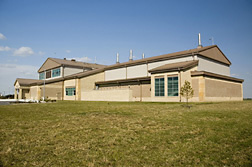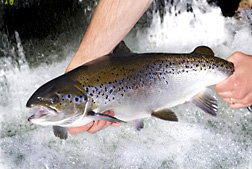Federal-Wide Partnering for a Better Life
The Agricultural Research Service continually looks for opportunities to partner with other federal agencies. These partnerships are designed to augment research programs, expedite research results, exchange information and knowledge, enhance U.S. trade and the nation’s economy, and improve the quality of life for all Americans.
The improvement of quality of life includes cooperative research for clean water; safe, plentiful, and high-quality food; and the health of our people, our livestock, and the environment.
Since its founding in 1953, ARS has worked closely with other federal agencies, both within and outside the U.S. Department of Agriculture. Examples include giving science-based recommendations to USDA Natural Resources Conservation Service (NRCS) personnel for use with farmers and ranchers and providing data to guide U.S. Environmental Protection Agency (EPA) regulations. ARS has worked with almost every other federal agency at one time or another, including the U.S. Departments of Defense and Homeland Security.
ARS often shares the same land or buildings with other federal agencies or with universities. “In fact, many ARS scientists do their work in university facilities alongside university researchers,” says Steven R. Shafer, ARS deputy administrator for Natural Resources and Sustainable Agricultural Systems. “This is a long-standing partnership with a highly distinguished tradition of productivity, arising through a leveraging of federal and state resources.”
ARS takes a lead role nationally in a “greening” initiative designed to encourage offices in all federal departments to set an example by doing things such as using fuel-efficient vehicles and biobased fuels and buying biobased versions of products such as cleaners and carpet backing.
A new collaboration between ARS and the USDA Agricultural Marketing Service has been established to coordinate market-driven research strategies across agencies. An ARS-developed computer crop-growth model for potatoes is an example of a research product being shared among agencies for financial and marketing guidance: The USDA Farm Services Agency wants to use it to assess loan risk and to guide loan applicants in the selection of profitable rotation crops.
Partnering for Clean Water
Making sure that taxpayers are getting their money’s worth from publicly funded conservation measures is the goal of the Conservation Effects Assessment Project (CEAP). Most of the funds for agricultural conservation come from USDA through the Farm Security and Rural Investment Act, known as the “Farm Bill.”
CEAP involves multiple partnerships among federal, state, and local government agencies; universities; and private organizations, including environmental groups such as the Sierra Club. The project now has 38 watersheds throughout the country, from the New York City area to California.
The lead USDA agencies in CEAP include ARS, NRCS, and the Cooperative State Research, Education, and Extension Service.
Conservation practices being assessed include conservation buffers; streambank fencing; erosion control; wetlands conservation and restoration; establishment of wildlife habitat; and management of grazing land, tillage, irrigation water, nutrients, and pests.
EPA cooperates with various aspects of the project. Additionally, many CEAP watersheds are in areas where EPA and states are investing Clean Water Act funds to improve water quality and protect drinking water.
The Cannonsville, New York, watershed is a good example of the type of cost/benefit analysis being done through CEAP. Its nearly 355 square miles drain into a reservoir that is part of a system of reservoirs and aqueducts supplying about 94 percent of New York City’s drinking water. Excess phosphorus, probably from farm waste, stimulates algal blooms that interfere with chlorination. New York City’s water authority decided that underwriting the costs of conservation practices installed by farmers was a better buy than the technological fix of changing treatment methods for its drinking water.
|
|
Partnering for Healthy Animals
This year, a new facility housing the National Centers for Animal Health (NCAH) will open for business in Ames, Iowa. Around 1 million square feet of laboratories, animal housing, and other facilities will be occupied by hundreds of scientists and support personnel—and hundreds of animals.
USDA scientists from ARS and the Animal and Plant Health Inspection Service (APHIS) already work side-by-side in Ames. They support the nation’s $100 billion livestock industry with animal disease research, diagnostics, and training. They also test vaccines and evaluate veterinary biological products.
ARS conducts much of USDA’s scientific research. APHIS, which is USDA’s regulatory arm for diagnosing animal diseases and licensing vaccines and diagnostics, will have two centers within the NCAH: the National Veterinary Services Laboratories (NVSL) and the Center for Veterinary Biologics (CVB).
“Sharing a physical workspace will allow ARS scientists to fine-tune the research that supports APHIS regulatory activities,” says Steven Kappes, who is the ARS Deputy Administrator for Animal Production and Protection.
NVSL director Beth Lautner agrees. “The new NCAH quarters will facilitate even stronger partnerships between ARS and APHIS,” she says.
Scientists will have access to state-of-the-art Biosecurity Level 3 (BSL-3) animal-containment facilities at NCAH to study a range of endemic, zoonotic, and foreign animal diseases. BSL-3 structures are designed to contain infectious pathogens that may cause serious or potentially lethal diseases.
“These world-class facilities will streamline and enhance not only the partnership between APHIS and ARS, but also the capabilities of the laboratories,” says CVB director Rick Hill.
Partnering for Healthy People
Nearly 50 years ago, Congress mandated that a national survey be conducted periodically to collect statistical data about the current dietary intake and health of people in the United States. USDA conducted a series of nationwide food-consumption surveys to assess U.S. dietary intakes. In addition, the U.S. Department of Health and Human Services (DHHS) provided dietary-survey data as part of the National Health and Nutrition Examination Survey (NHANES).
In the last decade, the leadership of USDA-ARS and DHHS completed a major integration of these two dietary surveys. The resulting national food and nutrient survey is called What We Eat In America.
The current national survey is based on a highly efficient, customized dietary data-collection method called the Automated Multiple Pass Method, or AMPM. The AMPM was developed by researchers at the ARS Food Surveys Research Group (FSRG), part of the Beltsville [Maryland] Human Nutrition Research Center (BHNRC). AMPM is carried out during the NHANES and involves both in-person and telephone interviews.
BHNRC researchers also maintain large databases of the nutrient values of foods that are key to accurately estimating the amount of nutrients in foods that survey respondents report eating. FSRG researchers use those nutrient data profiles to process survey results. They produce data tables that show how much fat, protein, vitamins, and minerals people consume on average, by gender, age, and income categories. They also determine how U.S. diets measure up to dietary standards designed to maintain health and prevent chronic diseases.
The new survey’s data are released jointly by USDA-ARS and DHHS in 2-year cycles and so far include 2001-2002, 2003-2004, and 2005-2006.
The dietary survey data, nutrient intake tables, and related analytical studies are used by various private and public groups to assess the effects of diet and health policies and programs.—By Don Comis, Ann Perry, and Rosalie Marion Bliss, Agricultural Research Service Information Staff.
This research is part of Animal Health (#103), Human Nutrition (#107), Aquaculture (#106), and Water Resource Management (#201), four ARS national programs described on the World Wide Web at www.nps.ars.usda.gov.
To reach scientists mentioned in this article, contact Don Comis, USDA-ARS Information Staff, 5601 Sunnyside Ave., Beltsville, MD 20705-5129; phone (301) 504-1625, fax (301) 504-1486.
|
|
Improving Aquaculture Feed
Alternative feeds are making a splash in the aquaculture industry.
Most feed for farm-raised fish includes lots of fishmeal. This places pressure on the source—wild ocean-dwelling fish—so the aquaculture industry is investigating alternatives.
The U.S. Department of Agriculture is collaborating with the National Oceanic and Atmospheric Administration to promote development of nontraditional aquaculture feeds. The initiative involves two USDA agencies: the Agricultural Research Service and the Cooperative State Research, Education, and Extension Service.
“The agencies have made great progress, meeting with representatives from universities, industry, interest organizations, and the general public to identify research needs and outline plans,” says Jeff Silverstein, leader of ARS’s national program for aquaculture.
Ongoing research for this initiative has helped shed light on nutritional profiles of potential feed alternatives and methods for increasing the level of nutrients available in novel feed ingredients such as plants, biofuel coproducts, and fish-processing wastes.—By Laura McGinnis, Agricultural Research Service Information Staff.
|
|
A Planet’s Genomes, Revealed
There’s something almost breathtaking about uncovering the genetic code of a living thing. Perhaps that’s because this probing takes us so close to the very essence of whatever organism we’re investigating, whether it’s a plant, an insect, a microbe, or some other form of life.
Many ARS scientists are engaged in deciphering genomes of everything from plants that feed us—such as soybean—to those, like switchgrass, that may someday fuel our world.
Some of the genome investigations are collaborations with the U.S. Department of Energy’s Joint Genome Institute in Walnut Creek, California, or with other partners such as Washington University, in St. Louis, Missouri, or the Eli and Edythe L. Broad Institute of the Massachusetts Institute of Technology and Harvard University.
Every snippet of information elicited from these projects will eventually become public, accessible to all who want to avail themselves of this remarkable new knowledge.—By Marcia Wood, Agricultural Research Service Information Staff.
"Federal-Wide Partnering for a Better Life" was published in the March 2009 issue of Agricultural Research magazine.












